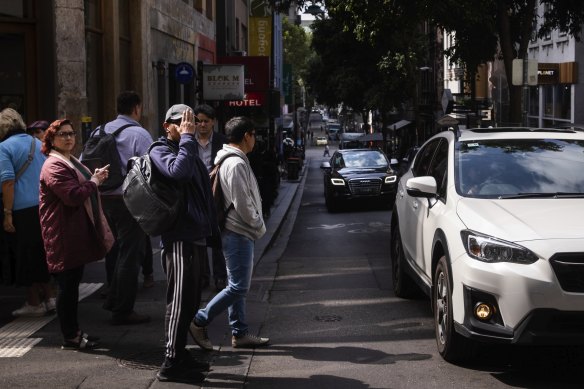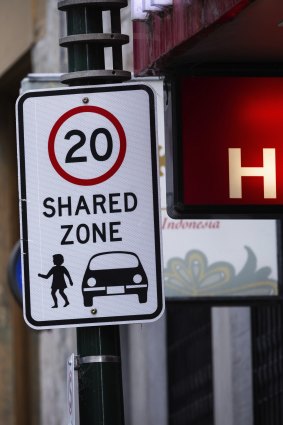An attempt to turn Melbourne’s “Little” streets into pedestrian-friendly promenades is failing because motorists refuse to share the busy laneways and obey new speed limits.
Flinders Lane, Little Collins, Little Bourke and Little Lonsdale streets became “shared zones” in September 2020, with pedestrians given right of way and speed limits lowered from 40 km/h to 20 km/h.
Pedestrians have right of way on Little Bourke Street but rarely use it. Credit:Paul Jeffers
The City of Melbourne intended the trial changes to create “vibrant, fun and inviting spaces” and ease crowding on footpaths on the four streets, which in some sections are used by up to 10 times more pedestrians than vehicles.
But a review of the trial commissioned by the council and released online this week has found motorists and pedestrians do not understand or follow the new rules.
“For the most part, pedestrians and drivers were unaware of the priority rules within the shared zone,” the assessment by planning consultancy Stantec says. “Pedestrians generally waited for cars to pass before crossing the street and drivers were rarely observed yielding to pedestrians.”
One exception was Finders Lane at the intersection of the Degraves Street laneway, where the road is raised to footpath level and pedestrians “were observed confidently crossing the street without yielding to cars”.
The review says the council should install more “traffic-calming” designs – like raised street sections, planter boxes or dining parklets – and paint or pave the streets to differentiate them from regular roads, where vehicles have priority.
Little Collins Street closes to vehicles between midday and 2pm on weekdays and the review says the council should close part of each street to traffic during busy times.
A “shared zone” sign on Little Bourke Street. Credit:Paul Jeffers
Victoria Walks executive officer Ben Rossiter said erecting signs indicating that the street was a “shared zone” was insufficient to change how people used them.
“It’s not surprising that behaviour hasn’t changed, because the design of the streets hasn’t changed,” Rossiter said. “People often drive at the speed that feels right for a street. If it looks and feels like a 40km/h street, some will go faster than the 20km/h limit.”
During the lunchtime rush on Tuesday, office worker Harin Mohan was one of the many pedestrians who waited for vehicles to pass before crossing Little Bourke Street at Hardware Lane, despite having right of way.
Mohan said he would never walk onto the street assuming vehicles would stop for him. “I value my life,” he said. “There are no lines saying it’s a pedestrian crossing.”
The review recommends widening the many “extremely narrow” footpaths on the Little streets, which all had sections too small for the number of pedestrians using them.
Vehicle numbers have fallen between 16 and 25 per cent across the four streets since the changes were implemented, but the streets are still too busy to be shared pedestrian zones, the report says.
Average driving speeds on the four streets have only fallen slightly and many motorists break the new 20km/h speed limit. The “85th percentile speed” – a measure traffic engineers use to assess driving speeds – was 22 km/h on Flinders Lane and about 25 km/h on the other streets.
“Further traffic-calming measures to reduce speeds would create a safer and more attractive environment,” the review says.
The review will go before the council at a meeting on April 4. If endorsed, the council will consider new surface treatments, signage and lines and permanent road humps to slow traffic down further and reinforce pedestrians’ priority on the four streets.
Lord Mayor Sally Capp said the shared streets were “economic drivers for the city and create safe, activated and enjoyable places for residents, workers and visitors to be in”.
“We’re taking action to make our iconic ‘Little’ streets even safer – easing traffic congestion and improving accessibility, while creating opportunities for more vibrant dining and entertainment hubs that our city is renowned for,” she said.
The Morning Edition newsletter is our guide to the day’s most important and interesting stories, analysis and insights. Sign up here.
Most Viewed in National
From our partners
Source: Read Full Article


